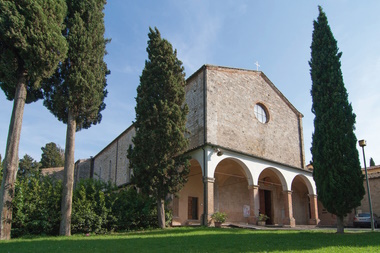Church of San Lucchese
It’s one of the most beautiful churches in gothic style of Val d’Elsa’s area and it was built around 1252 to bury the saint that has named it, Lucchese.
The church was originally born as parish of Camaldo’s village, situated in front of the hill of Poggio Imperiale and, according to a legend, founded by Fiesole’s inhabitants, escaped from their city after its destruction in 1010.
THE CHURCH AND THE FRANCISCANS
According to the tradition, in 1220 the church of S. Maria de Vico Camalduli was given, together
with two houses, to friar Francesco D’Assisi by the municipality of “Poggiobonizio”, during his second jouney in the area.
Here the monk met Lucchese from Gaggiano, who was the first Franciscan tertiary to whom, later, the church was dedicated.
The presence of Minor Friars is testified just since August 8th 1235, when a monk of the convent, Martino, partecipeted to the appoitment of “Poggiobonizio”’s ambassador aimed to the conclusion of a peace treaty with Florence and Orvieto. The Franciscan friars, at the beginning, just restored the small romanic church as on October 28th 1236 pope Gregory IX gave to the provost of Poggibonsi the permission to build a new complex.
To finance the construction, the monks received many donations from citizens, charitable that grew after the death of Lucchese in 1251.
In 1440 the Convent moved under the Congregation of Observance’s control and for 25 times, between 1461 and 1580, it was chosen as location of its meetigs.
In the meanwhile, important restorantions were carried on like the realization of the portal, the spire and of the facade’s porch.
In 1810, after the Napoleonic laws, the Convent was suppressed and the friars dismissed.
In 1814 San Lucchese was declared curia and in 1817 the church’s building were sold to a private citizen: Francesco Frosini Martinucci.
SAN LUCCHESE AND ARTWORKS
In 1895, the church’s chapels were badly damaged but, between 1903 and 1905, and later, in 1910, the large window and the facade’s opening were recovered and San Lucchese’s chapel was restored by the achitect Giuseppe Castellucci.
In 1925 the Franciscan friars took possession again of the Covent and immediately after, in 1930-32, renovation works were carried on.
Other restructuring measures were taken in 1948, as a remedy to damages caused by war, and in 1987 under the directions of the Superintendence to the monuments of Siena.
During the restaurations, ruins of the ancient church of S. Maria in Camaldo were found on the west side of San Lucchese’s church. Preceded by a simple porch, the building had the typical shape of the beggar plant, featuring a gabled facade with an opening on the top.
The bell tower is of modern construction and on the right there’s a cloister.
Among the artwoks we can admire inside San Lucchese’s church, on the left trasept, there’s the chapel of the saint painted with the Storie di Santo Stefano, realised by Cennino Cennini in 1388.
In the left side of the aisle, there’s San Nicola di Bari, a painting by Bartolo di Fredi and, closer to the entrance, there’s the reredos of Giovanni della Robbia dated back to 1517, portraying the Madonna col Bambino e Santi.
Loc. San Lucchese, 16
Telefono: 0577 936212



